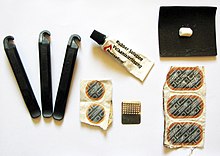Repair kit
A repair kit is a collection of tools and materials for repair of a tire , primarily the tubing in bicycles. Because of the included solvent-based adhesive, it has a limited shelf life.
Components
Repair kits are often offered as a complete set in a small, easily transportable package. Usually it consists of:
- various patches made of rubber in different sizes to cover the hole
- a tube with vulcanizing (gum solution) for fixing the patch on the tube
- a piece of sandpaper , if necessary a spare piece or a rasp, to roughen the rubber for adhesion
- several tire levers , mainly made of hard plastic , to lift the casing off the rim.
application
The vulcanizing liquid is used like a contact adhesive , i.e. H. After the liquid has been applied as evenly as possible, it should first dry off before the patch is put on. The patch should sit correctly on the first attempt as soon as possible, as the adhesion is reduced if a patch that has already been applied is removed again to correct the position. Double, thin application of the vulcanizing liquid increases the strength of the vulcanization. After the patch has been affixed, it should be pressed on briefly, but with as much force as possible. If a firm, level surface is available, a hammer can be used to tap the patch into place with several light taps. Alternatively, the patch can be pressed on with a screw clamp. Occasionally, it is recommended not to re-inflate the hose straight away after the repair, but rather to let it vulcanize overnight.
There are also quick-release patches that, like a sticker, are only stuck to the hole in the tube and do not require any chemicals. However, these are significantly more expensive than conventional repair kits and their durability is controversial. There are also patches for repairing tires (or coats). However, here (for cars and trucks) the size of the damage as well as the speed and load index of the tire must be observed.
Sources of error
The most common reasons for badly adhering patches:
- The area coated with adhesive was not previously roughened until it appeared evenly matt or existing seams and protrusions in the rubber had not been completely sanded off.
- The vulcanizing fluid was of poor quality or too old, or it was applied so thickly that it was not completely dry by the time the patch was applied.
- The patch was too stiff or too small to expand when the tube was inflated. In particular, patches that are attached to the side of the tube facing the rim, as well as patches near the valve, must be elastic and sufficiently large.
- The tube or the rim were too narrow for the tire used, so that the tube had to expand a lot in order to completely fill the tire. The manufacturers indicate for which tire widths the tube is suitable. Possible combinations of tires and rims can be found in the ETRTO table .
- The tire was driven with little air pressure, so that the strong flexing motion caused the patch to come off the tube.
literature
- Rob van der Plas: The bicycle workshop - repair and maintenance step by step . 1st edition, BVA Bielefelder Verlaganstalt, Bielefeld, 1995, ISBN 3-87073-147-8
- Michael Reimer, Wolfgang Taschner: Bicycle repair . 1st edition, Bruckmann Verlag GmbH, Munich, 2005, ISBN 3-7654-4063-9
- Richard Hallet: Bicycle Maintenance-Care-Repair . 1st edition, BVA Bielefelder Verlag GmbH & Co. KG, Bielefeld, 2003, ISBN 3-87073-308-X
